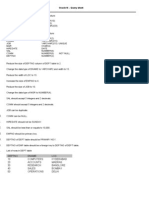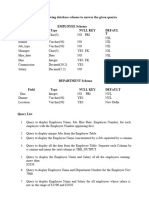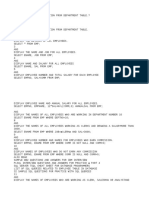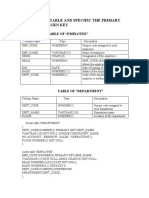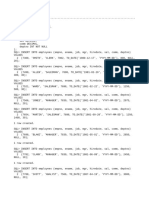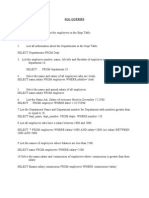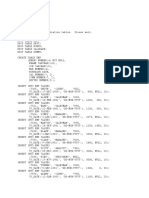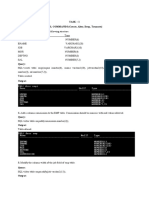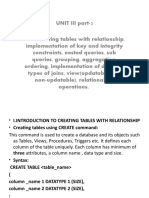0 ratings0% found this document useful (0 votes)
63 viewsSQL Practice
The document describes the creation of EMP and DEPT tables in a database. The EMP table stores employee data like employee number, name, job, manager, hire date, salary, commission, and department number. It has constraints like primary key and foreign key. The DEPT table stores department data like department number, name, and location. It also has a primary key constraint. Sample data is inserted into both tables.
Uploaded by
Abhi KumCopyright
© © All Rights Reserved
We take content rights seriously. If you suspect this is your content, claim it here.
Available Formats
Download as DOCX, PDF, TXT or read online on Scribd
0 ratings0% found this document useful (0 votes)
63 viewsSQL Practice
The document describes the creation of EMP and DEPT tables in a database. The EMP table stores employee data like employee number, name, job, manager, hire date, salary, commission, and department number. It has constraints like primary key and foreign key. The DEPT table stores department data like department number, name, and location. It also has a primary key constraint. Sample data is inserted into both tables.
Uploaded by
Abhi KumCopyright
© © All Rights Reserved
We take content rights seriously. If you suspect this is your content, claim it here.
Available Formats
Download as DOCX, PDF, TXT or read online on Scribd
You are on page 1/ 4
CREATE TABLE EMP (
EMPNO NUMBER(4) NOT NULL,
ENAME VARCHAR2(12),
JOB VARCHAR2(20),
MGR NUMBER(4) CONSTRAINT EMP_SELF_KEY REFERENCES EMP (EMPNO),
HIREDATE DATE,
SAL NUMBER(7,2),
COMM NUMBER(7,2),
DEPTNO NUMBER(2) NOT NULL,
CONSTRAINT EMP_FOREIGN_KEY FOREIGN KEY (DEPTNO) REFERENCES DEPT (DEPTNO),
CONSTRAINT EMP_PRIMARY_KEY PRIMARY KEY (EMPNO));
INSERT INTO EMP VALUES (7839,'KING','PRESIDENT',NULL,'17-NOV-81',5000,NULL,10);
INSERT INTO EMP VALUES (7698,'BLAKE','MANAGER',7839,'1-MAY-81',2850,NULL,30);
INSERT INTO EMP VALUES (7782,'CLARK','MANAGER',7839,'9-JUN-81',2450,NULL,10);
INSERT INTO EMP VALUES (7566,'JONES','MANAGER',7839,'2-APR-81',2975,NULL,20);
INSERT INTO EMP VALUES (7654,'MARTIN','SALESMAN',7698,'28-SEP-81',1250,1400,30);
INSERT INTO EMP VALUES (7499,'ALLEN','SALESMAN',7698,'20-FEB-81',1600,300,30);
INSERT INTO EMP VALUES (7844,'TURNER','SALESMAN',7698,'8-SEP-81',1500,0,30);
INSERT INTO EMP VALUES (7900,'JAMES','CLERK',7698,'3-DEC-81',950,NULL,30);
INSERT INTO EMP VALUES (7521,'WARD','SALESMAN',7698,'22-FEB-81',1250,500,30);
INSERT INTO EMP VALUES (7902,'FORD','ANALYST',7566,'3-DEC-81',3000,NULL,20);
INSERT INTO EMP VALUES (7369,'SMITH','CLERK',7902,'17-DEC-80',800,NULL,20);
INSERT INTO EMP VALUES (7788,'SCOTT','ANALYST',7566,'09-DEC-82',3000,NULL,20);
INSERT INTO EMP VALUES (7876,'ADAMS','CLERK',7788,'12-JAN-83',1100,NULL,20);
INSERT INTO EMP VALUES (7934,'MILLER','CLERK',7782,'23-JAN-82',1300,NULL,10);
CREATE TABLE DEPT (
DEPTNO NUMBER(2) NOT NULL,
DNAME VARCHAR2(10),
LOC VARCHAR2(10),
CONSTRAINT DEPT_PRIMARY_KEY PRIMARY KEY (DEPTNO));
INSERT INTO DEPT VALUES (10,'ACCOUNTING','NEW YORK');
INSERT INTO DEPT VALUES (20,'RESEARCH','DALLAS');
INSERT INTO DEPT VALUES (30,'SALES','CHICAGO');
INSERT INTO DEPT VALUES (40,'OPERATIONS','BOSTON');
Assignment:
1. Retrieve the entire contents of EMP table.
select * from EMP;
2. Print the name of employees.
3. Retrieve the list of names and jobs of employees.
4. List of various department available from dept table.
5. List names of employees whose job is MANAGER.
6. List names of employee having salary greater than equal to 3000.
7. List all employees having ‘A’ as second letter in their names.
8. List all information about the Employees and the structure of the EMP table.
9. Select the structure of the DEPT table. Show the information of the Department
table.
10. the contents of the column Empno, Ename as Employee Name and Sal from the
Emp table.Display
11. List the Employee Number, Name, Hiredate and Job Title of the Employees in the
Department 10.
12. Display the details of those Employees who earn a monthly Salary of more than
2000.
13. Display the names of all Employees from Department 10 and 20 whose name start
with “A” and ends with “B”.
14. Display the details of the employees who have joined on 21-DEC-1990.
15. Display the Job, Comm and Ename from the Emp table with Customized column
headings.
16. Display the Employee Code, Name, Job & Annual Salary for all Employees belonging
to Department Number 10.
17. Display the details of the Employees who earn an Annual salary of more than
25000. Sort the records in the descending order of Salary.
18. Display the names of Employees whose names contain the character “F”.
19. Display the location as “Location” and names of all the departments as
“Department Names”.
20. Display the Names and Numbers of all Departments in the descending order of the
Department Names.
21. Display the Name, Employee Number, Designation and Salary of those Employees
who earn a monthly salary of not less than 1000 and not more than 2000.
22. Find out the Bonus (Bonus 1.1% of Annual Salary) that every person will receive at
the end of the year.
23. Display the Name, Job and Dept No. of all the Employees who either work in
Department 30 or in Department 40.
24. Display the Employee Number, Name for Clerks and Managers who’s Salary is more
than 1500.
25. Display the Name, Annual Salary and Commission as “Commission Earned” of all
employees whose monthly salary is greater than their Commission. The output
should be in decreasing order of salary. If two or more employees have same salary,
then sort them by name within the highest order of salary.
26. Display the Name and Job of sales executives or managers whose names end with
the letter ‘S’.
27. Display all the Names of the Employees whose Salary is either more than 1000 but
not more than 2200.
28. Select Name & Salary of employees who are clerks.
29. List the Department Number and Names of all Employees having Salary less than
2500.
You might also like
- Oracle Assignment 2019: Grade NUMBER, Losal NUMBER, Hisal NUMBERNo ratings yetOracle Assignment 2019: Grade NUMBER, Losal NUMBER, Hisal NUMBER8 pages
- S.No. Topic Date Sign. Remark 1. 2. 3. 4. 5. 6. Display The Employees Name With Their Annual Salary. 7. 8. 9. 10No ratings yetS.No. Topic Date Sign. Remark 1. 2. 3. 4. 5. 6. Display The Employees Name With Their Annual Salary. 7. 8. 9. 1038 pages
- Key and Forigen Key: 1. Create A Table and Specific The PrimaryNo ratings yetKey and Forigen Key: 1. Create A Table and Specific The Primary5 pages
- Project: Faculty of Business and ManagementNo ratings yetProject: Faculty of Business and Management3 pages
- List All Information About All Employees From Emp Table: SQL Select From Emp Where Deptno Not in (10,30,40)No ratings yetList All Information About All Employees From Emp Table: SQL Select From Emp Where Deptno Not in (10,30,40)7 pages
- DB2 11.1 for LUW: SQL Basic Training for Application DevelopersFrom EverandDB2 11.1 for LUW: SQL Basic Training for Application DevelopersNo ratings yet
- Pivot Tables for everyone. From simple tables to Power-Pivot: Useful guide for creating Pivot Tables in ExcelFrom EverandPivot Tables for everyone. From simple tables to Power-Pivot: Useful guide for creating Pivot Tables in ExcelNo ratings yet
- Mongodb From Scratch: Mastering Nosql DatabaseNo ratings yetMongodb From Scratch: Mastering Nosql Database58 pages
- Ngo Duc Thang-Nguyen Do Tung Lam-INS2080-Co So Du Lieu-Tran Thi OanhNo ratings yetNgo Duc Thang-Nguyen Do Tung Lam-INS2080-Co So Du Lieu-Tran Thi Oanh21 pages
- SQL Tutorial Prepared By: Kaba N. DanielNo ratings yetSQL Tutorial Prepared By: Kaba N. Daniel60 pages
- Program: 1: Aim: To Create A New User AccountNo ratings yetProgram: 1: Aim: To Create A New User Account34 pages
- Example Program To Find The Sum of 2 Numbers Using Rmi Inter - JavaNo ratings yetExample Program To Find The Sum of 2 Numbers Using Rmi Inter - Java18 pages






















